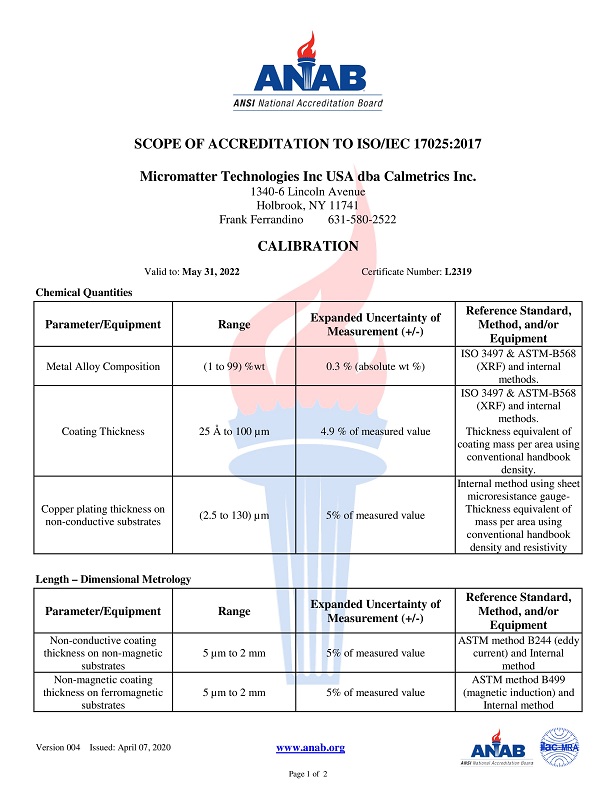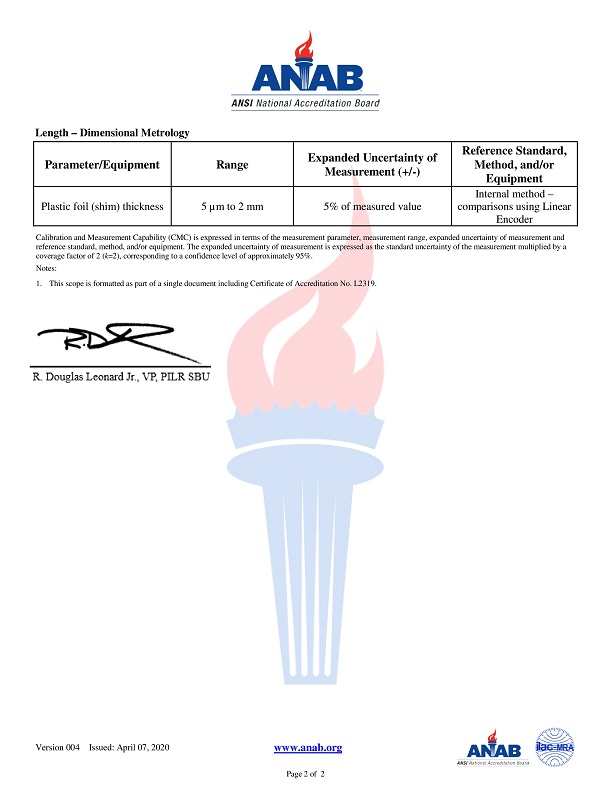Calmetrics Inc was founded in November, 2002 as a supplier of coating thickness and material composition standards, as well as analytical laboratory services. The principle members of Calmetrics Inc. each began their careers with the original UPA Technology Inc company. UPA Technology was a world leader in coating thickness measurement instrumentation during the 1970’s and 1980’s. However, at the end of 1986, UPA Technology was acquired by Veeco Instruments. Calmetrics personnel continued with Veeco, developing and producing standards as well as providing application support and instrument product support to Veeco customers. In May 2002, Veeco sold its XRF business to Thermo Electron. Later that same year, Calmetrics was founded and began negotiating with Thermo to acquire the exclusive rights to its calibration standards business. In August of 2003, Calmetrics completed an agreement with Thermo Electron which granted Calmetrics an exclusive license to Thermo’s reference standard development and manufacturing technology. Thermo also agreed to use Calmetrics exclusively as its supplier of calibration standards for its XRF products. At this point, Calmetrics personnel ceased working directly for Thermo Electron to devote their efforts exclusively to the development and improvement of calibrations standards manufacturing methods and measurement techniques. Upon completion of the agreement with Thermo, Calmetrics moved into a new 3,300 square foot facility which houses the same equipment and processes used by Thermo and formerly, Veeco, for the development and production of calibration standards. Since that time, we have acquired several additional pieces of deposition and analytical tools to expand and enhance both our manufacturing and metrological activities. In addition, Calmetrics established ISO 17025 accreditation, further enhancing its reputation as a leading developer and producer of film thickness and composition certified reference standards.
Calmetrics Inc is dedicated to being a leading worldwide supplier of standard reference materials which will meet or exceed the expectations of our customers who use them for calibration and testing. Our management team is committed to a continuous improvement quality program rooted in the principles and requirements embodied within ISO17025. The Calmetrics management team regularly reviews, evaluates and amends as necessary, the Quality Management System, as well as identifies and makes available the appropriate resources needed, to provide an ever more satisfying interaction and result for our customers. As a small company with a working management team, all personnel are expected to be familiar with and implement the policy, objectives and intent of our quality program.
Accuracy is the measure of how well a measurement value agrees with an established reference or a physical constant or calculated physical value based on accepted physical or chemical principles. In the case of coating thickness, there are no physical constants or calculations based on theoretical considerations that can be used to evaluate accuracy of coating or film thickness. As such, accuracy is evaluated based on comparisons with other known references. National Metrological Institutes (NMI) such as US NIST make available to industry a limited selection of certified coating thickness reference standards. In the absence of any theoretical evaluations, comparison of Calmetrics standards to congruent standards provided by US NIST and other NMI’s is one way to evaluate absolute accuracy of Calmetrics standards. Howver, no certified reference standards are provided by NIST or other NMIs for most of the coating thickness and material composition standards developed and produced by Calmetrics. Therefore, accuracy is evaluated on the basis of comparisons of thickness values measurement by Calmetrics to other measurement methods which can be used to evaluate coating thickness. As an accredited laboratory, the ISO 17025 standard requires that we perform such comparisons annually to confirm the accuracy of our measurement results. In these cases accuracy is judged by how closely our measurement values agree with measurement values obtained by other measurement methods and/or other laboratories.


